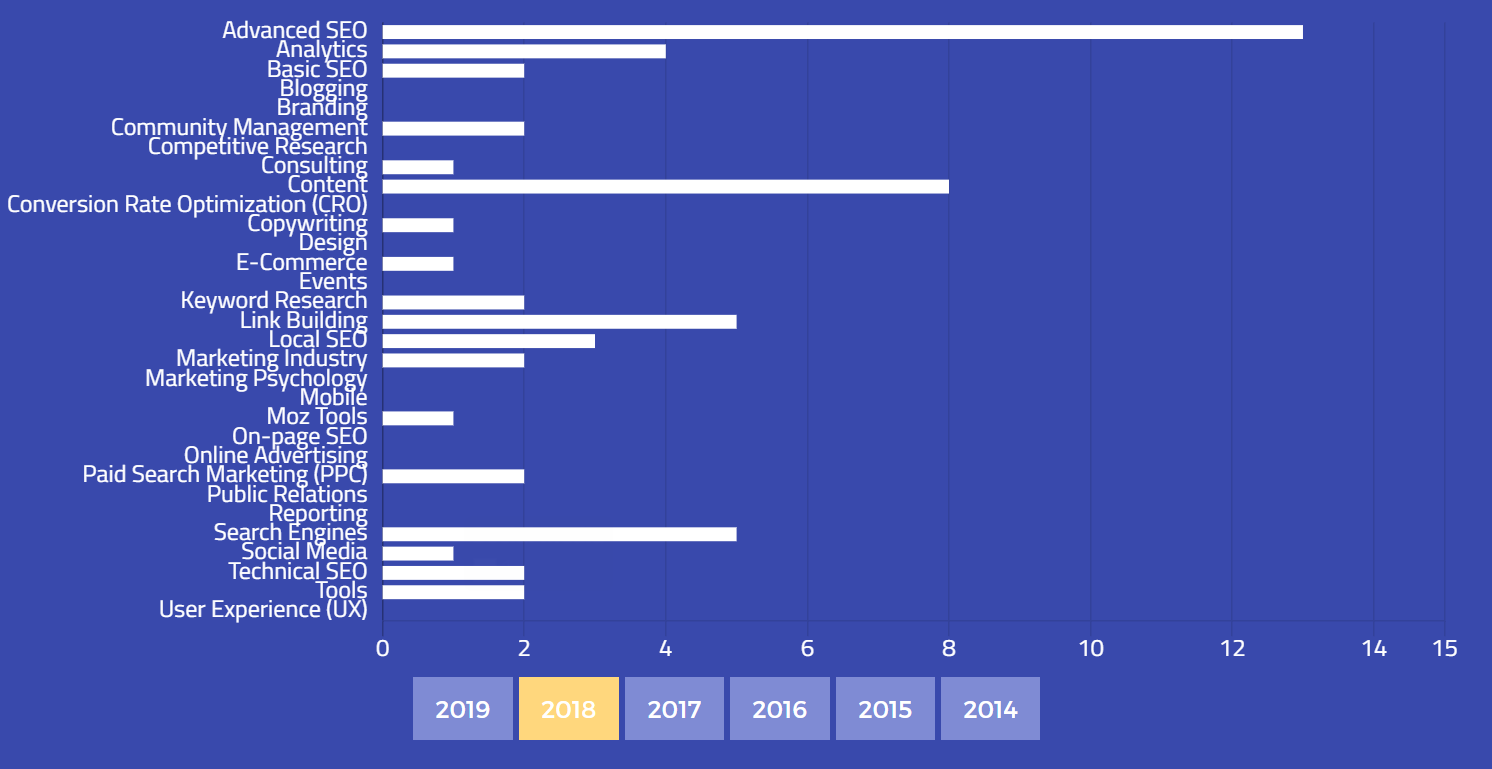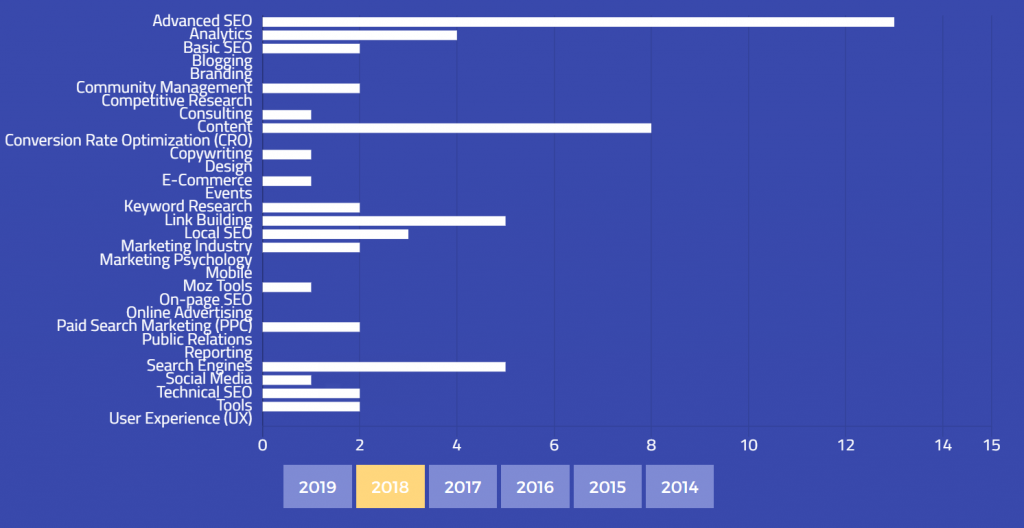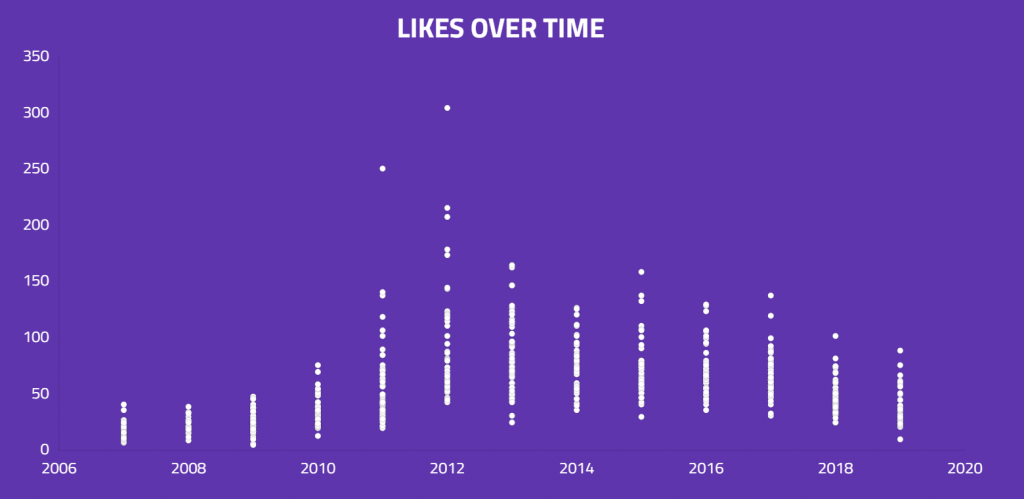The Whiteboard Friday series from Moz is a digital marketing powerhouse. Over more than a decade, they’ve pumped out weekly videos (give or take) that drill into almost every aspect of marketing online.
Initially famed for their SEO prowess (Moz used to be SEOMoz, after all), the series reflects the evolution of the industry. You’ll still find tons of videos about SEO – from basic through to advanced – but you’ll also find posts about PR, UX, CRO, and various other types of marketing peppered throughout.
Here’s what they covered in 2018, for example:
We created an interactive infographic about the history of WBF, and it has a lot to teach.
Not only is the WBF series a source of almost-unlimited digital marketing wisdom, but it’s also a fantastic case study in how to effectively create content for SEO purposes.
In today’s world, pretty much every company creates content. Whether on their blog, their Youtube channel, one or more social media channels, or some combination of the above.
But how many of them create effective content?
This post contains five tips for creating effective, high-quality content that will improve your site’s SEO. All five are taken straight from the Moz WBF playbook.
#1 Give people a way to engage
Discussion strengthens content. If you have a blog or a Youtube channel, turn comments on. Invite people to join the conversation, and make sure you join in too! Reply to people’s contributions, and they’ll feel compelled to contribute again.
Head over to any WBF post and you’ll most likely find at least twenty comments. You’ll also note that you can hit ‘like’ – a quick way to show your appreciation for a post.
By giving readers a way to engage with your content, you increase the likelihood of them returning to your site to read more. Metrics like page views, repeat page views, and time-on-page are thought to be ranking factors, so making engagement easier will pay dividends in SEO terms.
#2 Give people options
You can navigate to the Moz website and click through to the Whiteboard Friday pages, or you can get the posts delivered to your inbox.
You can watch the videos with sound, or on mute with subtitles. If you don’t feel like watching, you can read the full transcript of the video. There are also images of the whiteboard so you can see snapshots of information at a glance.
Giving your readers flexibility with how they interact with your blog is another way to boost engagement. Realistically, not many people are going to navigate directly to your blog for the latest post. They’re going to want to be notified when it’s published via email, social media, or RSS.
Ensuring your blog covers all these bases will go one step further toward increasing your engagement metrics and, in turn, your rankings.
#3 Tap into the expertise of the community
If you run a business, it’s likely that you employ at least a few other people. Each of these will have their own skillset and opinions on your industry, and each is a suitable contender to contribute to the creation of content.
And if you’re a one-man (or one-woman) band, there are other figures in your industry who you could invite to contribute.
Take a look at Moz WBF. Although Rand Fishkin is in the majority of videos, there’s an enormous roster of guest contributors. Some of these are one-time guests, others have contributed many times over the years:
Not only is this great for breathing life into your blog and increasing its appeal, but it’s a great way to encourage shares and wider distribution of your content. People who contribute are more likely to share the content amongst their networks, further boosting your engagement metrics. Links and social shares are also ranking factors, so this wider distribution will have a positive impact on your SEO.
#4 Be reliable and predictable
If your blog is a ghost town, it may be doing more harm than good.
Head over to WBF and you’ll see that they’ve published a new video pretty much weekly for over a decade. It is remarkable dedication, and it strengthens the SEO credentials of the series massively.
Google looks at content freshness as part of its manual reviewer site guidelines. In an increasing number of industries, people are hired to trawl through search results and cross-reference the sites that rank with a set of criteria. The goal is for Google to improve quality of rankings by making refinements to the algorithm based on findings from manual review.
Fresh content is a trust factor. It implies that content is up to date, and the insights it contains are accurate. People looking at your site will subconsciously evaluate whether it looks like a reliable resource, and fresh content is a factor that can positively influence this assessment.
Post regularly, and you will enjoy SEO benefits.
#5 Be fun
Rand Fishkin likes to play dress-up:
While he’s been renowned as an SEO superhero for the best part of a decade (the proof is right here on PPC.org), he’s also dressed as a magician, a Victorian, Santa, and literally hundreds of other things.
It’s fun, and it shows that Moz doesn’t take itself too seriously.
The whole point of a blog is to provide information in a way that is engaging and enjoyable. We mentioned engagement metrics earlier: to keep people coming back, you need to show them that your content is fun and digestible.
While we’re not necessarily recommending you call the costume department, do bear in mind that you’re creating content for the human reader first. The tone should reflect that, and you should try your best not to be boring!
Let’s wrap it up
The tips come down to three key things: increasing engagement, incentivising sharing and linking, and appearing trustworthy. Bake these factors into your blog content – alongside technical SEO to strengthen your blog – and we’re confident you’ll see SEO gains.








